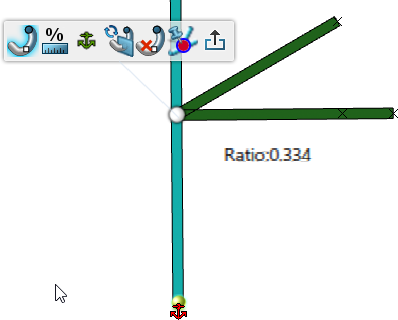Fundamentals
Editing the route of a primary branch can modify the shape of the branch's curve. As a consequence:
- The position of branch points defined on the curve are updated according to the new shape of the branch.
- The updated position of the branch points modifies the shape of the secondary branches connected to the branch points.
Adding a Fixed behavior to a branch point allows to prevent the absolute position (xyz coordinates) of the branch point from being modified even if the route of a primary branch is edited.
Even if the primary branch is modified, the parameters of the branch point are updated to ensure that the branch point keeps its absolute position on the branch's curve.
As a consequence, the secondary branches connected to branch points with a Fixed behavior are not impacted by the modifications made on the primary branch. They keep their position and their shape.
Example
In the following example, a branch point is positioned on a branch curve with a 0.162 ratio. Two branches from a secondary network are connected to the branch point.

If the branch's route is modified (in this example, the reference point of the branch point is moved), the update of the branch point depends on its behavior:
| Branch Point Update without Fixed behavior |
Branch Point Update with Fixed behavior |
|---|---|

|

|
Behavior Setting
Setting a Fixed behavior on new and existing branch points is available from the context toolbar dedicated to the edition of branch points:
- Clicking
 allows
to define a Fixed behavior on the branch point.
allows
to define a Fixed behavior on the branch point. - Clicking
 allows to
remove the Fixed behavior.
allows to
remove the Fixed behavior.
The same icons appear in the 3D area to indicate if a branch point has a Fixed behavior or not.
Moreover, an option allows to specify a Fixed behavior by default on every new branch point.
The Create branch points with fixed behavior by default option is available in .
Eligible Branch Points
A Fixed behavior can only be defined on standard branch points and on proxy branch points.


